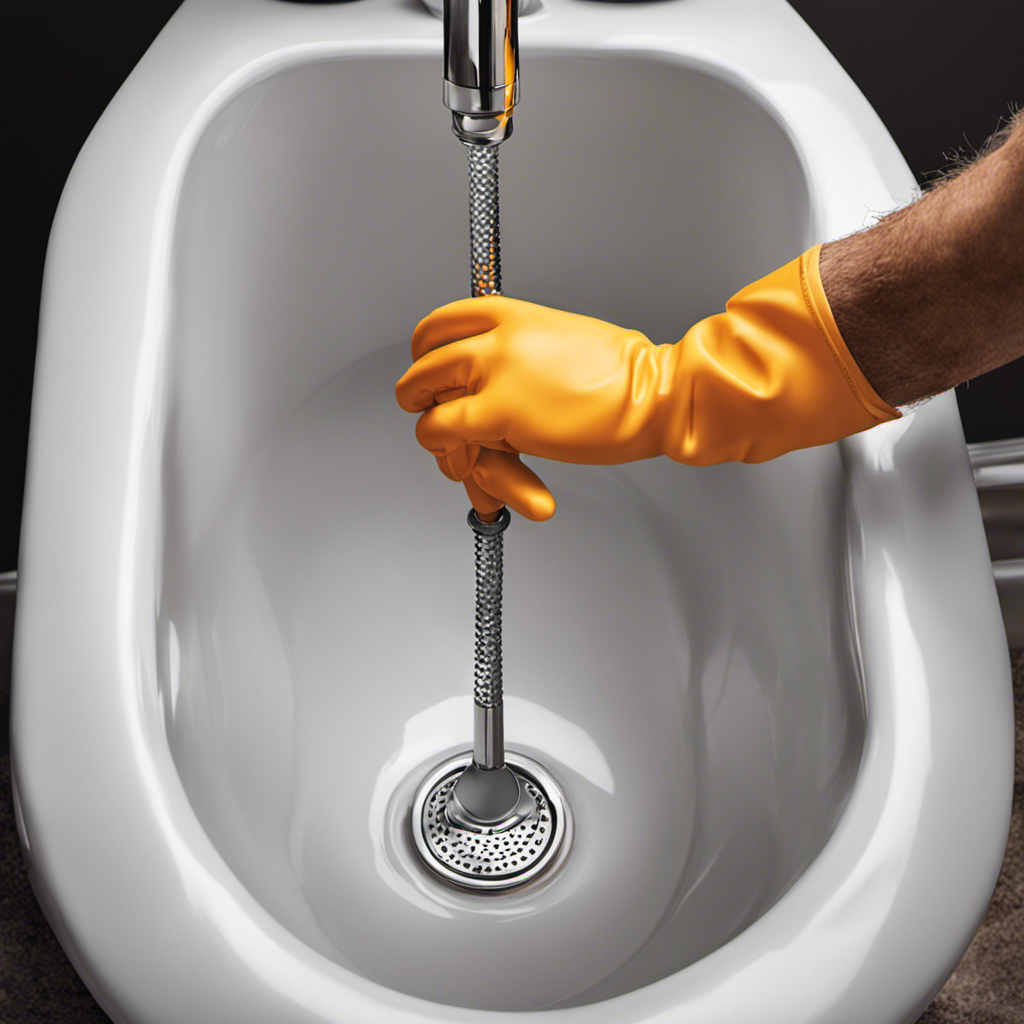I’ve always wondered how to hand wash clothes in the bathtub without making a mess. Well, after some trial and error, I’ve finally figured it out.
In this article, I’ll share with you my step-by-step process for efficiently hand washing your clothes in the bathtub.
From preparing the bathtub and gathering supplies to gently washing and properly drying your clothes, I’ve got you covered.
So, let’s dive in and get those clothes clean!
Key Takeaways
- Clean the bathtub thoroughly before washing clothes
- Sort and pre-treat clothes based on color and fabric type
- Use the recommended water temperature for washing based on fabric type
- Choose a suitable detergent that is gentle on fabrics and eco-friendly
Prepare the Bathtub and Gather Supplies
First, make sure you’ve gathered all the supplies you’ll need and prepared the bathtub for washing your clothes. To start, clean the bathtub thoroughly to ensure your clothes stay clean. You don’t want any dirt or residue from previous uses to transfer onto your clothes.
Next, fill the tub with warm water, making sure there’s enough water to fully submerge your clothes. If you don’t have access to a washing machine, using the bathtub is a great alternative. It allows you to clean your clothes efficiently and effectively.
Once the bathtub is clean and filled with water, you’re ready to move on to the next step: sorting and pre-treating your clothes.
Sort and Pre-Treat Your Clothes
Next, you’ll want to separate and treat your garments before starting the process of hand washing them in the bathtub. This step is crucial in preventing color fading and removing stubborn stains.
Here’s what you need to do:
-
Sort your clothes based on their color and fabric type. This will prevent color bleeding and damage caused by mixing incompatible fabrics.
-
Pre-treat any stubborn stains by applying a stain remover directly to the affected area. Gently rub the stain remover into the fabric and let it sit for a few minutes.
-
For delicate fabrics, consider using a gentle hand wash detergent or a specialized cleaner to avoid damaging the material.
-
Pay extra attention to heavily soiled areas such as collars and cuffs. Use a soft brush or your fingers to scrub the stains gently before soaking the garment in the bathtub.
Fill the Bathtub With Warm Water
When it comes to washing clothes in the bathtub, there are a few key factors to consider.
First, the water temperature plays a crucial role in effectively cleaning your garments. It is recommended to use warm water, as it helps to break down dirt and stains more efficiently.
Secondly, choosing the right detergent is essential for achieving clean and fresh-smelling clothes. Opt for a mild detergent that is suitable for handwashing and gentle on fabrics.
Lastly, the drying method you choose can impact the overall result. Hang your clothes in a well-ventilated area or use a drying rack to avoid shrinking or damaging the fabric.
Water Temperature for Washing
To determine the water temperature for washing, you should start by checking the care label on your clothes. This will provide you with important information about the recommended water temperature for the fabric.
Here are some key points to consider when it comes to water temperature and fabric care:
-
Hot water (above 130°F/54°C) is suitable for white cotton and sturdy fabrics, as it helps to remove tough stains and kill bacteria.
-
Warm water (between 90°F/32°C and 110°F/43°C) is ideal for most colored fabrics and synthetic materials, as it effectively cleans without causing damage.
-
Cold water (below 80°F/27°C) is best for delicate fabrics, such as silk and wool, as it prevents shrinking and fading.
-
Always avoid using hot water for delicate or sensitive fabrics, as it can cause them to lose shape or color.
Choosing the Right Detergent
If you want your clothes to be clean and fresh, you should make sure you choose the right detergent for your laundry. There are different detergent types available in the market, each with its own benefits and features.
For those who are conscious about the environment, eco-friendly options are a great choice. These detergents are made using natural ingredients and are free from harmful chemicals, making them safe for both your clothes and the planet. Not only will they effectively clean your clothes, but they also help reduce water pollution and minimize your carbon footprint.
Now that you have chosen the right detergent, let’s move on to the next step: drying methods and tips.
Drying Methods and Tips
Using a dryer is a convenient way to dry your laundry quickly and efficiently. However, there are times when air drying is the better option. Here are some tips for air drying your clothes:
- Use a clothes rack to hang your clothes. This will help them dry evenly and prevent them from getting wrinkled.
- Hang your clothes outside if the weather permits. The fresh air and sunlight will help remove any odors and kill bacteria.
- If you don’t have access to an outdoor space, hang your clothes in a well-ventilated area indoors.
- Avoid overcrowding the clothes rack. Give each garment enough space to allow air circulation.
Air drying your clothes is not only environmentally friendly, but it can also help prolong the life of your garments.
Now that you know how to dry your clothes, let’s move on to the next step: adding detergent and agitating the water.
Add Detergent and Agitate the Water
Once you’ve filled the bathtub with water, grab some detergent and start swirling it around to agitate the water. Choosing the right detergent is essential for effectively washing your clothes by hand. Look for a detergent specifically designed for hand washing or a gentle formula that won’t damage your clothes. Avoid using bleach or harsh chemicals, as they can cause discoloration or fabric damage.
To ensure proper soaking, follow these techniques:
| Technique | Description |
|---|---|
| Gentle agitation | Swirl the water gently to evenly distribute the detergent and allow it to penetrate the fabric fibers. |
| Soaking time | Let your clothes soak for at least 15-30 minutes to loosen dirt and stains. |
| Spot treating stains | Apply a small amount of detergent directly to stubborn stains and gently rub it in with your fingers. |
| Avoid overcrowding | Don’t overload the bathtub; give your clothes enough space to move around during agitation. |
Gently Hand Wash Your Clothes
When it comes to hand washing clothes, there are a few key points to keep in mind.
First, proper soaking time is crucial for removing dirt and stains effectively. I’ll explain how long you should soak your clothes and why it’s important.
Next, I’ll discuss gentle agitation techniques that help clean your clothes without causing damage.
Proper Soaking Time
Make sure you let your clothes soak in the bathtub for at least 30 minutes. Soaking is an essential step in hand washing clothes as it helps to loosen dirt and stains, making them easier to remove. Here are some reasons why proper soaking time is important:
-
Allows detergent to penetrate: Soaking allows the detergent to fully dissolve and penetrate the fabric, ensuring a thorough clean.
-
Helps to avoid color bleeding: Soaking helps to minimize the risk of color bleeding, as it allows the excess dye to be released before agitating the clothes.
-
Removes odors: Soaking helps to eliminate stubborn odors from clothes, especially if they have been worn for a long time or exposed to strong smells.
-
Softens fabrics: Soaking can help to soften stiff fabrics, making them more comfortable to wear.
Gentle Agitation Techniques
To properly agitate your garments, gently swish them in the water to ensure an even distribution of detergent and thorough cleaning. Start by filling the bathtub with enough lukewarm water to cover the clothes.
Add a small amount of gentle detergent, making sure to follow the instructions on the label. Carefully submerge the clothes, making sure each item is fully saturated. Using your hands, gently scrub any stained or soiled areas, applying a bit more pressure if needed. Be mindful not to stretch or twist the fabric.
Allow the clothes to soak for a few minutes to let the detergent penetrate the fibers. This gentle scrubbing will help remove dirt and grime without causing damage.
Once you have finished agitating your garments, it’s time to move on to the next step: drying without wringing.
Drying Without Wringing
Be careful not to wring out your damp garments, as this can cause stretching and damage to the fabric. Instead, opt for air drying your clothes using a clothesline.
Here are some tips for drying your clothes without wringing them:
-
Shake out the excess water: Gently shake your clothes to remove any excess water before hanging them up.
-
Use a hanger: Hang your clothes on a hanger to help them retain their shape while drying.
-
Avoid direct sunlight: Hang your clothes in a shaded area to prevent them from fading or becoming discolored.
-
Allow for proper airflow: Make sure there is enough space between each garment to allow for proper airflow and faster drying.
By following these tips, you can ensure that your clothes dry properly without causing any damage.
Now, let’s move on to the next step: rinsing and drying your clothes properly.
Rinse and Dry Your Clothes Properly
Start by gently wringing out excess water from your clothes before hanging them up to air dry. After rinsing your clothes in the bathtub, it’s important to remove as much water as possible to ensure efficient drying.
To do this, I recommend using a gentle squeezing motion to gradually squeeze out the water from the fabric. Avoid twisting or wringing the clothes too forcefully, as this can damage the fibers.
Once you have removed the excess water, carefully hang your clothes up to dry. Choose a well-ventilated area with good air circulation to facilitate quicker drying. You can use a clothesline or a drying rack, making sure to spread out the clothes evenly to encourage even drying.
Conclusion
In conclusion, hand washing clothes in the bathtub may seem like a daunting task, but with the right preparation and technique, it can be a simple and efficient way to clean your garments.
By following the steps outlined above, you can ensure that your clothes are thoroughly cleaned and well-maintained.
So, next time you find yourself without a washing machine, don’t fret! Just grab your supplies and get ready for a satisfying and effective hand washing experience.
Remember, a little bit of extra effort goes a long way in keeping your clothes fresh and clean.










